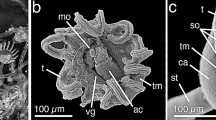Summary
Tentacle number in non-buddingHydra attenuata, randomly selected from mass culture varies <0.5 tentacles over a 3 month period. Replicate samples of untreated regenerates (n=50–60), however, show some variability in mean tentacle number regenerated (S x0.13–0.15). The variability is similar whether experiments are performed using randomly selected animals or animals with identical tentacle numbers. The variability is, further, not the result of profound differences in the time of tentacle initiation in individual animals.
Addition of 10−5 M glutamate or a methanol extract to the assay medium results in both an earlier appearance of tentacles and in more tentacles being regenerated during early time periods. The mean tentacle number of methanol extract-treated animals is significantly higher than the mean tentacle number of either control or glutamate-treated animals at all time periods examined.
The distribution of tentacle number classes among regenerates is normal in control and glutamate-treated animals but nonparametric in methanol extract-treated animals, making statistical analysis of the data using Student'st-test in-appropriate. The usefulness of the Mann WhitneyU and Kruskal-Wallis tests is discussed, as is the appropriateness of tentacle regeneration as an assay forhydra morphogens.
Similar content being viewed by others
References
Berking S (1979) Analysis of head and foot formation inHydra by means of an endogenous inhibitor. Wilhelm Roux's Archives 186:189–210
Berking S, Gierer A (1977) Analysis of early stages of budding inhydra by means of an endogenous inhibitor. Wilhelm Roux's Archives 182:117–129
Burnett AL (1973) Biology ofhydra. Academic Press, New York London San Francisco
Gibson, JD (1976) Nonparametric methods for quantitative analysis. Holt, Rinehart, and Winston, New York
Kanaev II (1952)Hydra, Lenhoff H (ed) Originally published Soviet Acad Sci, Moscow
Lenhoff HM, Brown RD (1970) Mass culture inhydra: an improved method and its application to other aquatic invertebrates. Lab Animals 4:139–154
Lenhoff HM, Loomis WF (1961) The biology ofhydra. Univ of Miami Press, Miami
Lesh GE, Burnett AL (1966) An analysis of the chemical control of polarized form inhydra. J Exp Zool 163:55–78
Lesh-Laurie GE, Flechtner VR, Hood RL (1980) Purification and analysis ofhydra morphogen. In: Tardent P, Tardent R (eds) Developmental and cellular biology of coelenterates. Elsevier/ North-Holland Biomedical Press, Amsterdam, pp 401–406
Lesh-Laurie GE, Hang L (1972) Tentacle morphogenesis inHydra. I. The morphological effect of actinomycin D. Wilhelm Roux's Archives 169:314–334
Muscatine L, Lenhoff HM (1965) Symbiosis ofhydra and algae. I. Effects of some environmental cations on growth of symbiotic and aposymbiotic hydra. Biol Bull 128:415–424
Roulon O, Child CM (1937) Observations and experiments on developmental pattern inPelmatohydra oligactis. Physiol Zool 10:1–13
Sacks PG, Davis LE (1979) Production of nervelessHydra attenuata by hydroxyurea treatments. J Cell Sci 37:189–204
Schaller HC (1975) A neurohormone fromhydra is also present in the rat brain. J Neurochem 25:187–188
Schaller H, Gierer A (1973) Distribution of the head-activating substance inhydra and its localization in membranous particles in nerve cells. J Embryol Exp Morphol 29:27–38
Schaller HC, Schmidt T, Grimmelikhuijzen CJP (1979) Separation and specificity of action of four morphogens fromHydra. Wilhelm Roux's Archives 186:139–149
Siegel S (1956) Nonparametric statistics for the behavioral sciences. McGraw-Hill Book Co Inc, New York
Shostak S (1979) Digestive cell and tentacle number in freshly detached buds ofHydra viridis. Int J Invert Repro 1:167–178
Shostak S, Medic D Jr, Sproull FA, Jones CC (1978) Tentacle number in culturedHydra viridis. Biol Bull 155:220–234
Sokal RR, Rohlf FJ (1969) Biometry. WH Freeman and Co. San Francisco Reading
Author information
Authors and Affiliations
Rights and permissions
About this article
Cite this article
Flechtner, V.R., Lesh-Laurie, G.E. & Abbott, M.K. Evaluation of tentacle regeneration as a biological assay inHydra . Wilhelm Roux' Archiv 190, 67–72 (1981). https://doi.org/10.1007/BF00848397
Received:
Accepted:
Issue Date:
DOI: https://doi.org/10.1007/BF00848397




